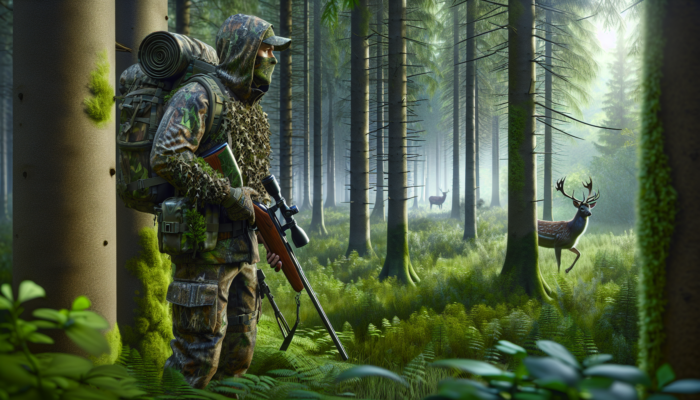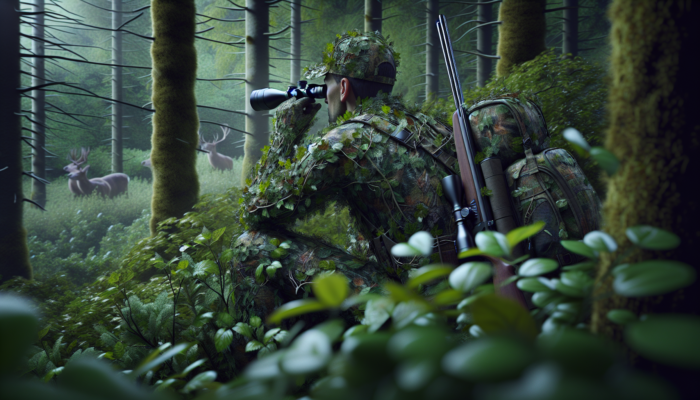Enhance Your Silent Hunting Skills with Expert Stealth Techniques
Understanding the Vital Importance of Stealth in Successful Hunting

Mastering stealth is an essential skill for anyone determined to become an accomplished hunter. The capacity to approach your target game without raising suspicion dramatically increases your chances of a successful hunt. Wildlife has highly developed senses, such as sight, smell, and hearing, finely tuned to detect any signs of human presence. As a dedicated hunter, your primary goal is to remain concealed, enabling you to get as close to your target as possible and make your shot with pinpoint accuracy. The ongoing struggle between predator and prey creates a complex dynamic, making the enhancement of your hunting stealth techniques indispensable. Achieving this level of mastery elevates you from a casual participant to a strategic predator, significantly enhancing your overall effectiveness in the hunting field.
Furthermore, the psychological aspect of stealth plays a crucial role in hunting success. Maintaining a calm and unobtrusive demeanor not only increases your chances of making a successful kill but also enriches your experience in the great outdoors. By moving quietly and seamlessly integrating into your surroundings, you create opportunities to observe the behaviors of wildlife more closely, yielding invaluable insights that can shape your future hunting strategies. Additionally, demonstrating respect for animals and their habitats is a foundational aspect of ethical hunting, making the cultivation of stealth skills vital for conscientious hunters dedicated to responsible practices.
Proven Techniques for Quiet Movement During Your Hunting Adventure
To excel in hunting stealth techniques, a solid grasp of the fundamentals of silent movement is crucial. One essential aspect is understanding foot placement; aim to step on softer surfaces, such as grass or fallen leaves, instead of harder ground that tends to create noise. Practicing the whisper step technique—first placing your heel down and then gently rolling your foot forward—can significantly reduce sound levels as you navigate through your hunting terrain. This technique is vital for remaining undetected while getting closer to your game.
Moreover, being acutely aware of your surroundings is paramount. Different environments present unique challenges and advantages. For instance, while moving through a forest, utilize fallen leaves and branches to muffle your footsteps and diminish noise. Conversely, when traversing rocky areas, proceed with caution and deliberation, as the sound of shifting stones can easily alert nearby wildlife. Maintaining a low profile is equally crucial; keeping your body close to the ground enhances your ability to blend into various backgrounds, subsequently minimizing the risk of detection by your target.
Moreover, mastering breath control is an often-overlooked aspect of stealth hunting. Quick and shallow breaths can generate unnecessary noise, especially when you are in close proximity to your quarry. Practicing deep, controlled breathing allows you to manage anxiety and sustain focus, ensuring that you remain calm during high-pressure moments in the field when every sound counts.
Enhance Your Stealth with Proven Camouflage Strategies
The effective use of camouflage is vital for improving your hunting stealth techniques. The right gear enables you to blend effortlessly into your environment, significantly lowering the chances of being detected by your target. This includes selecting clothing that matches the colors and patterns of your hunting setting—earthy tones for wooded areas and lighter shades for open fields—to enhance your disguise.
Additionally, the materials of your clothing can dramatically influence your stealth effectiveness. Opt for soft fabrics that absorb sound rather than reflect it, as this is essential for maintaining silence. Furthermore, consider incorporating scent-masking fabrics that neutralize human odors, thereby reducing the likelihood of alarming the game to your presence. This is particularly important when hunting species with a keen sense of smell.
Investing in a high-quality ghillie suit can further bolster your efforts at concealment. These suits are specifically crafted to disrupt your outline and replicate natural elements in your surroundings, making it increasingly difficult for animals to pinpoint your exact location. However, while effective camouflage is critical, it should be complemented with adept movement techniques and situational awareness to maximize its effectiveness during your hunting expeditions.
Sharpen Your Perceptual Abilities for Superior Stealth Hunting

Developing acute sensory perception is essential for achieving success in stealth hunting. Paying close attention and being observant in your environment can significantly enhance your hunting outcomes. Start by engaging in active listening exercises in quiet settings. Focus on identifying subtle sounds—like rustling leaves, snapping twigs, or distant animal calls. This practice will help you detect animal presence long before they come into view, providing you with a crucial advantage in the field.
Your visual acuity can also be enhanced through dedicated training. Spend time observing wildlife and their behaviors, paying particular attention to their responses to different stimuli. This keen observation can yield valuable insights into their movement patterns, enabling you to anticipate their actions and plan your approach more effectively.
Furthermore, honing your sense of smell is important for understanding how animals interpret their environment. Familiarize yourself with the scents associated with various species and learn techniques to mask your own scent. Simple exercises, such as identifying different natural scents in your surroundings, can enhance your olfactory senses and allow you to become more attuned to the subtleties of nature.
Explore Advanced Techniques for Mastering Stealth in Hunting
Perfect the Art of Stalking Your Prey with Precision
Stalking is an intricate skill that constitutes a fundamental aspect of hunting stealth techniques. This sophisticated art form demands attention to detail regarding foot placement, body control, and awareness of the environment. To become an effective stalker, concentrate on your footfalls—gently placing your foot down and leveraging the terrain to your advantage. Soft surfaces, like moss or grass, create ideal conditions for silent movement, allowing you to approach without alerting your target.
Practicing body control is equally essential. Keep your body low and make your movements fluid to avoid producing unnecessary noise that might startle your prey. Utilize your arms for balance and stability while steering clear of sudden movements that could alarm nearby animals. Consistency is crucial; maintaining a slow and steady pace minimizes the risk of errors, while a hurried approach may jeopardize your chances of success.
Learning to read animal tracks and signs can also enhance your stalking capabilities. Familiarize yourself with the habitats of your desired species by observing their feeding and bedding areas. This knowledge will empower you to anticipate their movements, positioning yourself advantageously for a successful hunt.
Leverage Terrain to Gain Stealth Advantages

The natural landscape can serve as a powerful ally in your quest for stealth. Understanding how to effectively utilize the terrain can help mask your presence and enhance your movements. For example, consider using natural cover such as trees, shrubs, or rocks as shields when closing in on areas where you suspect game may be located, allowing you to approach more discreetly.
Elevation can provide a strategic advantage as well. Positioning yourself higher up, whether in a tree stand or on a ridge, grants you a wider perspective of the landscape while keeping you concealed from below. In addition, navigating along natural features like valleys or ridges can help you avoid open areas where you may be more vulnerable to detection, thus enhancing your stealth approach.
Wind direction is another critical factor to consider during your approach. Always remain cognizant of the wind's trajectory; approaching from downwind prevents your scent from alerting the game. Similarly, leveraging the terrain to create wind barriers can further bolster your stealth capabilities, allowing you to approach your target undetected.
Adjusting Stealth Techniques to Accommodate Varied Weather Conditions
Weather conditions can significantly impact your hunting stealth techniques. Adapting your strategies based on environmental factors is vital for maintaining effectiveness in the field. For instance, rain can muffle sounds, allowing for quieter movement, but it can also create muddy terrain that generates noise. Being aware of these nuances is crucial.
In windy conditions, use the wind to your advantage by moving against it to mask your scent. However, be cautious that strong winds can carry sounds, so adjust your pace and volume accordingly. Additionally, visibility may be limited for both you and the game during foggy or overcast conditions, which creates unique opportunities for a closer approach than usual.
Understanding animal behavior in relation to different weather scenarios is equally important. Many species may exhibit increased activity under specific weather conditions, allowing you to tailor your strategy based on their anticipated behaviors, which can further enhance your chances of a successful hunt.
The Psychological Factors That Influence Stealth Hunting Success
The mental discipline required for successful stealth hunting is often overlooked. Maintaining focus and composure is crucial; even the slightest distraction can lead to detection. Building a strong mental framework can be just as important as mastering physical skills and techniques.
Before you set out on a hunt, prepare mentally by visualizing your approach and envisioning successful outcomes. This mental rehearsal can bolster your confidence and help you remain calm in the field. Additionally, adopting a patient mindset is essential, as stealth hunting often requires extended periods of waiting and observing, which can be challenging.
Practicing mindfulness techniques can enhance your concentration and awareness of the environment around you. This heightened awareness allows you to detect subtle changes in your surroundings, such as variations in animal behavior or unexpected sounds. Ultimately, the psychological components of stealth hunting can significantly elevate your performance and success rates in the field.
Essential Tools and Equipment for the Discerning Silent Hunter
Investing in Premium Gear for Optimal Stealth Efficiency
Investing in essential gear is critical for optimizing your performance in stealth hunting. A well-fitted camouflage outfit serves as the cornerstone of your stealth equipment. Seek clothing that strikes a balance between comfort, durability, and sound-dampening features to yield the best results.
Footwear plays an equally vital role in your stealth setup. Choose boots that offer both support and noise reduction. Soft-soled boots are particularly effective for stealth, enabling quiet movement across diverse terrains. Consider wearing gaiters to protect your legs and minimize noise from brush or undergrowth.
Other essential gear includes a silent backpack for transporting equipment, binoculars for scouting, and a reliable hunting knife. Each item should be meticulously chosen to enhance your stealth capabilities, ensuring that you remain undetected while pursuing your target.
Innovative Technologies Enhancing Stealth Hunting Experiences
As the hunting landscape continues to evolve, so too do the technologies available to hunters. Cutting-edge gear designed for stealth can dramatically enhance your field experience. For example, sound-dampening fabrics and materials are now commonly incorporated into hunting clothing, allowing for quieter movements that keep you concealed.
Modern camouflage options have also evolved, featuring advanced patterns and materials that closely replicate natural environments. Additionally, some manufacturers provide scent-masking technologies that neutralize human odors, significantly increasing your chances of remaining undetected by wary game.
The advancement of high-quality optics has transformed the hunting experience, enabling hunters to spot game from greater distances without revealing their positions. These technological innovations not only enhance stealth but also improve overall hunting success rates, making them invaluable tools for any serious hunter.
Maintaining Your Stealth Equipment for Long-Term Performance
Proper maintenance of your stealth gear is essential for ensuring its long-term effectiveness. Regular cleaning of your camouflage clothing is vital; dirt and grime can diminish its effectiveness, rendering you more visible to your target. Be sure to follow the manufacturer's care instructions meticulously to maintain the integrity of the materials.
Additionally, routinely inspect your footwear for signs of wear and tear. A damaged sole or upper can hinder your ability to move silently. Treat leather boots with waterproofing agents to extend their lifespan and ensure continued comfort during your hunts.
Your hunting accessories, including binoculars and knives, should also be adequately maintained. Regularly cleaning and sharpening your knife ensures optimal performance, while carefully storing optical devices protects against scratches or damage. By diligently caring for your equipment, you not only enhance your stealth capabilities but also improve your overall hunting experience.
Cost-Effective Solutions for Efficient Stealth Hunting
Not every hunter can afford high-end gear; however, effective hunting stealth techniques can still be achieved with budget-friendly options. Start by utilizing what you already possess—dark, muted clothing can be just as effective, provided it blends well with your surroundings.
Consider DIY camouflage solutions, such as using natural materials like leaves and branches to create cover. This approach not only saves money but also fosters a deeper connection with the environment, enhancing your overall hunting experience.
Moreover, prioritize acquiring essential items that offer the most significant benefits, such as quality footwear and accessories. Investing in a few key pieces rather than a complete set of high-end gear can help you maintain effective stealth without straining your budget, allowing you to enjoy your hunting pursuits.
Real-World Applications of Stealth Techniques in Various Hunting Scenarios
Customizing Stealth Hunting Techniques for Specific Game Species
Tailoring your stealth approach based on the behaviors and senses of different animals is critical for achieving hunting success. Distinct species possess unique characteristics that dictate how you should pursue them. For instance, deer have remarkable eyesight and are extremely alert, necessitating a more cautious approach with careful consideration of movement and wind direction.
On the other hand, predators such as foxes or coyotes heavily rely on their sense of smell, which makes scent control a top priority during hunting. Utilizing scent-masking products and remaining mindful of your movements can greatly improve your odds of success when pursuing these elusive species.
Understanding the habitat and behaviors of your target species enables you to develop a specific stealth strategy that maximizes your likelihood of a successful hunt. This adaptability is a hallmark of skilled hunters and is essential for effectiveness in the field.
Case Studies Highlighting Successful Stealth Hunts
Real-life examples of successful hunting stealth techniques can provide invaluable insights for aspiring hunters. One notable case involved a hunter successfully stalking a herd of elk. By employing natural cover and maintaining a position downwind, the hunter was able to observe the herd for an extended period before taking a well-timed shot.
Another example illustrates a hunter's experience in a dense forest environment. The hunter remained undetected by moving slowly and deliberately, utilizing the terrain features, and closely monitoring animal behavior, ultimately leading to a successful outcome.
These case studies emphasize the importance of patience, keen observation, and adaptability in stealth hunting. Learning from the experiences of others can help refine your techniques and strategies in the field, ultimately enhancing your hunting prowess.
Applying Stealth Hunting Techniques in Urban and Suburban Environments
Adapting hunting stealth techniques for urban and suburban settings presents unique challenges. Noise and human activity can complicate stealth approaches, but success remains attainable with careful planning and execution.
Timing is crucial for success in these regions. Early mornings or late evenings often provide optimal conditions when animal activity peaks and human presence diminishes. Utilize natural cover, such as hedges or fences, to camouflage your movements during these periods.
Understanding local regulations is also of utmost importance. To avoid complications, ensure that your hunting activities comply with laws and guidelines. By modifying your strategies to fit the urban landscape, you can maintain effective stealth while adhering to ethical and responsible hunting practices.
Ethical Considerations and Regulations in Stealth Hunting Practices
Responsible hunters must remain well-informed about the legal and ethical considerations surrounding hunting stealth techniques. Ethical hunting practices promote sustainability and wildlife conservation, ensuring that hunting activities are conducted responsibly. Always stay updated on local laws regarding hunting seasons, permissible areas, and species regulations to avoid any legal issues.
Respecting the animal and its environment is paramount. Avoid hunting practices that could lead to unnecessary suffering or threaten local populations. Embracing patience, restraint, and a commitment to ethical approaches enhances the overall hunting experience and fosters a responsible hunting culture that benefits future generations.
Engaging with local hunting communities can provide valuable insights into responsible practices and regulations. Sharing knowledge and experiences helps cultivate a culture of ethical hunting, ensuring the preservation of wildlife for future hunters.
Building Skills and Training for Mastery in Stealth Hunting
Participating in Workshops and Training Courses for Stealth Hunting Mastery
To elevate your hunting stealth techniques, participating in workshops and courses can offer invaluable education and hands-on experience. Numerous outdoor organizations provide specialized training focused on stealth and advanced hunting strategies, which can significantly enhance your skills.
These programs typically include practical field exercises, enabling participants to practice techniques in real-world scenarios. Learning from experienced instructors can accelerate your skill development and expose you to insights that might not be available through self-study.
Additionally, attending hunting expos and seminars can connect you with industry experts and fellow hunters, fostering a community of shared knowledge and resources that benefits all participants and encourages continuous improvement.
Practicing Stealth Techniques at Home to Enhance Your Skills
Improving your stealth capabilities doesn't always require a hunting trip; you can practice essential techniques at home. Simple exercises, such as walking quietly across different surfaces, can help you become more aware of your foot placement and overall movement, which are crucial for stealth.
Incorporate drills that focus on breath control and patience, such as remaining still while observing your surroundings. This practice enhances your ability to stay undetected in the field and increases your effectiveness as a hunter.
Mindfulness practices can also sharpen your awareness and focus, which are essential components of effective stealth hunting. By dedicating time to practice at home, you can build a solid foundation for future success when you venture into the field.
Learning from Experienced Stealth Hunters Through Mentorship
Seeking mentorship from seasoned hunters can significantly expedite your learning curve in hunting stealth techniques. Experienced hunters often possess a wealth of knowledge and insights that can prove invaluable to novices seeking to improve their skills.
Consider joining local hunting clubs or participating in guided hunts where you can learn from those with more experience. Observing their techniques and asking questions can provide practical knowledge that enhances your abilities and understanding of stealth approaches.
Moreover, building relationships with fellow hunters can create opportunities for collaboration and shared experiences, fostering a supportive hunting community that encourages ongoing learning and improvement.
Assessing Your Progress in Stealth Hunting Skills
Establish a self-assessment system to measure and track your improvement in stealth hunting. Maintaining a journal can be beneficial for documenting your experiences, techniques, and outcomes during your hunts. Reflecting on these experiences can illuminate areas for improvement and reinforce successful strategies that work well for you.
Additionally, seeking feedback from peers or mentors can provide valuable insights into your progress. Constructive criticism can guide you in refining your techniques and developing a more effective stealth approach to hunting.
Regularly revisiting your goals and adjusting your training methods can further enhance your development as a stealth hunter. Committing to continuous improvement can elevate your skills and increase your success rates in the field.
Overcoming Common Challenges in Stealth Hunting
Strategies for Effectively Navigating Noisy Terrain During Hunting
Maintaining stealth in noisy terrain can present significant challenges for hunters. However, with the right strategies, you can navigate these environments effectively. First, adjust your movements to mimic the natural sounds of the terrain. For example, if walking on gravel, move in a manner that blends with the sound of shifting stones, thereby minimizing your detectability and enhancing your chances of success.
Additionally, consider the timing of your approach. Hunting during inclement weather—such as rain or wind—can mask your movements and facilitate quieter passage through the area. Furthermore, taking slow, deliberate steps helps reduce noise, allowing you to maintain stealth while closing in on your target.
Utilizing natural cover, like bushes or trees, can also help conceal your presence from nearby game. By employing these strategies, you can successfully navigate noisy environments while remaining undetected, significantly improving your hunting effectiveness.
Managing Wind Direction and Scent Control for Enhanced Stealth Success
Wind direction is a crucial factor in your hunting stealth techniques. Understanding how to manage your scent is vital for successful stealth hunting. Always approach your target from downwind, allowing the wind to carry your scent away from the game you are pursuing, which is essential for maintaining stealth.
Utilizing scent-masking products, such as sprays or scent-free clothing, can significantly minimize your scent signature. Additionally, practicing good hygiene before your hunt—such as showering with unscented soap and avoiding heavily scented products—can further reduce the likelihood of detection by your prey.
Regularly monitor wind shifts during your hunt. Adjust your approach as the wind direction changes, ensuring that you remain undetected throughout your pursuit and increase your chances of a successful outcome.
Minimizing Human Error in Stealth Hunting Scenarios
Human error can occur in any hunting experience but can be minimized through careful planning and awareness. Common mistakes, such as sudden movements or loud noises, can alert the game and jeopardize your stealth. To combat this, practice mindfulness and focus on your actions.
Before beginning your hunt, take a moment to prepare and mentally visualize your approach. This mental rehearsal can help you remain composed and deliberate in your actions, ultimately improving your stealth capabilities.
Additionally, learning from past mistakes by maintaining a hunting journal can be incredibly beneficial. Reflect on what occurred during previous hunts and develop strategies to avoid repeating those errors. This self-awareness will enhance your overall effectiveness in the field and contribute to your growth as a stealth hunter.
Adapting to Unexpected Situations While Stealth Hunting
Unexpected challenges can arise during a hunt, and the ability to adapt is key to maintaining stealth. Flexibility is essential, whether it's a sudden noise, an unanticipated change in wind direction, or encountering other hunters in the area.
Stay calm and assess the situation before making decisions. If you encounter unexpected noise, pause and observe to determine its source. This moment of stillness can provide valuable insight into whether to proceed or adjust your approach accordingly.
Moreover, developing various strategies for different scenarios can enhance your adaptability in the field. Practicing diverse techniques in varied environments equips you to respond effectively to changing circumstances, ensuring your continued success as a stealth hunter.
The Future of Stealth Hunting Techniques
Emerging Trends Influencing the Future of Stealth Hunting
The landscape of hunting stealth techniques is in constant evolution, with emerging trends shaping the future of silent hunting. One significant trend is the increasing emphasis on sustainability and ethical practices. Today's hunters are becoming more conscious of their environmental impact, leading to a shift toward methods that prioritize conservation and responsible hunting practices.
Additionally, technological advancements are paving the way for innovative gear and equipment that enhance stealth capabilities. From sound-dampening materials to sophisticated camouflage patterns, these innovations are transforming the hunting experience for enthusiasts worldwide.
Furthermore, the rise of social media and online communities has fostered a culture of knowledge-sharing among hunters. This interconnectedness facilitates the exchange of ideas and techniques, further advancing the practice of stealth hunting and helping hunters stay updated on the latest strategies.
The Role of Technology in Advancing Stealth Hunting Techniques
Modern technologies are significantly impacting the development and application of hunting stealth techniques. For instance, mobile applications that provide real-time weather updates and wind direction forecasts can assist hunters in planning their approaches more effectively, thus enhancing their stealth capabilities.
Wearable technology, such as fitness trackers, can monitor physical performance and facilitate stealth movements. This data-driven approach allows hunters to assess their stamina and efficiency in the field, ultimately improving their overall effectiveness during hunts.
Moreover, advancements in optics and camera technology have revolutionized how hunters scout and observe game. High-definition binoculars and trail cameras offer unprecedented insights into animal behaviors, allowing for more strategic planning and execution during hunts.
Stealth Hunting and Sustainability: A Deepening Connection
The role of stealth hunting in sustainable wildlife management is gaining increasing recognition. Ethical hunting practices contribute to population control and habitat preservation, which are vital for maintaining healthy ecosystems.
Stealth hunting techniques enable more selective harvesting, minimizing the impact on animal populations. By exercising patience and restraint, hunters can ensure they only take what is necessary, aligning their activities with broader conservation goals.
Engaging in community-based conservation initiatives can also enhance the sustainability of hunting practices. Collaborating with local organizations to promote ethical hunting can create a positive impact on wildlife populations and habitats, reinforcing the connection between hunting and conservation.
Anticipating the Evolution of Stealth Hunting Practices
As the hunting landscape continues to shift, anticipating the future of hunting stealth techniques involves considering various factors. Environmental changes, technological advancements, and shifting cultural attitudes toward hunting will all shape future practices in this field.
Expect the integration of more sophisticated gear, such as augmented reality for scouting and tracking, which can enhance the hunting experience while preserving stealth. Additionally, an increased focus on conservation and ethical practices will likely influence hunting methods, promoting more responsible and sustainable approaches.
Ultimately, the evolution of stealth hunting practices will reflect a blend of tradition and innovation, ensuring that hunters continue to engage with the natural world in a respectful and effective manner.
Frequently Asked Questions About Stealth Hunting Techniques
What are the essential components of stealth in hunting?
Key components include silent movement, effective camouflage, sensory awareness, and an understanding of animal behavior. These elements are fundamental for a hunter to remain undetected while pursuing game.
How can I improve my stealth movement?
Focus on foot placement, slow and deliberate movements, and body control. Practicing exercises that emphasize quiet movement across various terrains can significantly enhance your stealth abilities and effectiveness.
What is the significance of camouflage in stealth hunting?
Camouflage enables hunters to blend into their surroundings, decreasing the visibility to the game. Properly selected clothing and materials are crucial for maximizing concealment and minimizing detection.
How can I train my senses for stealth hunting?
Engage in active listening exercises, observe wildlife behaviors, and practice scent recognition. These activities can sharpen your awareness and enhance your ability to remain undetected during hunts.
What advanced stalking techniques can I employ?
Advanced stalking techniques include careful foot placement, utilizing natural cover, and understanding animal behavior. Practicing these methods can significantly improve your ability to approach game quietly and successfully.
How can I adjust my hunting techniques based on weather conditions?
Modify your approach according to the weather—leverage rain to mask sounds, adapt to wind direction, and learn how animals behave differently under various conditions. Flexibility is key to maintaining stealth.
What essential gear should I have for stealth hunting?
Essential gear includes a well-fitted camouflage outfit, silent footwear, a quality hunting knife, and accessories like binoculars. Each item should be selected to enhance your stealth capabilities during hunts.
How can I effectively maintain my stealth equipment?
Regular cleaning and proper care of your gear are crucial. Adhere to manufacturer instructions for washing, storing, and inspecting your equipment to ensure longevity and optimal effectiveness.
What ethical considerations should I keep in mind while stealth hunting?
Always follow local regulations, prioritize sustainability, and respect wildlife. Ethical practices ensure responsible hunting and contribute to the preservation of ecosystems for future generations.
How can I track my progress in stealth hunting?
Keep a journal to document your experiences, techniques, and outcomes. Seek feedback from peers or mentors to evaluate your skills and make necessary adjustments for continuous improvement.
Discover more about our world on X!
The post Hunting Stealth Techniques for Mastering Silent Hunting appeared first on Survival Bite.
The Article Stealth Techniques for Mastering Silent Hunting Skills Was Found On https://limitsofstrategy.com


You’re spot on about the importance of stealth in hunting. I remember my first hunt—it was a real eye-opener. I thought I could just walk in like I owned the place, but the moment I stepped on a twig, every deer in the area seemed to vanish! It really made me appreciate how finely tuned their senses are.
Your experience resonates on so many levels. Walking into the wild with a certain swagger can really teach you a thing or two about nature’s unwritten rules. It’s fascinating how quickly animals pick up on disturbances in their environment. Those tiny, seemingly insignificant sounds—like a twig snapping—are the equivalent of a flashing neon sign to them, signaling that something’s not quite right.
“Absolutely! It’s amazing how quickly they sense even the slightest disturbance. If you’re looking to enhance your stealth skills further, check out this resource—it might just give you the edge you need!”
https://blognetwork.co.uk/eComToolkit